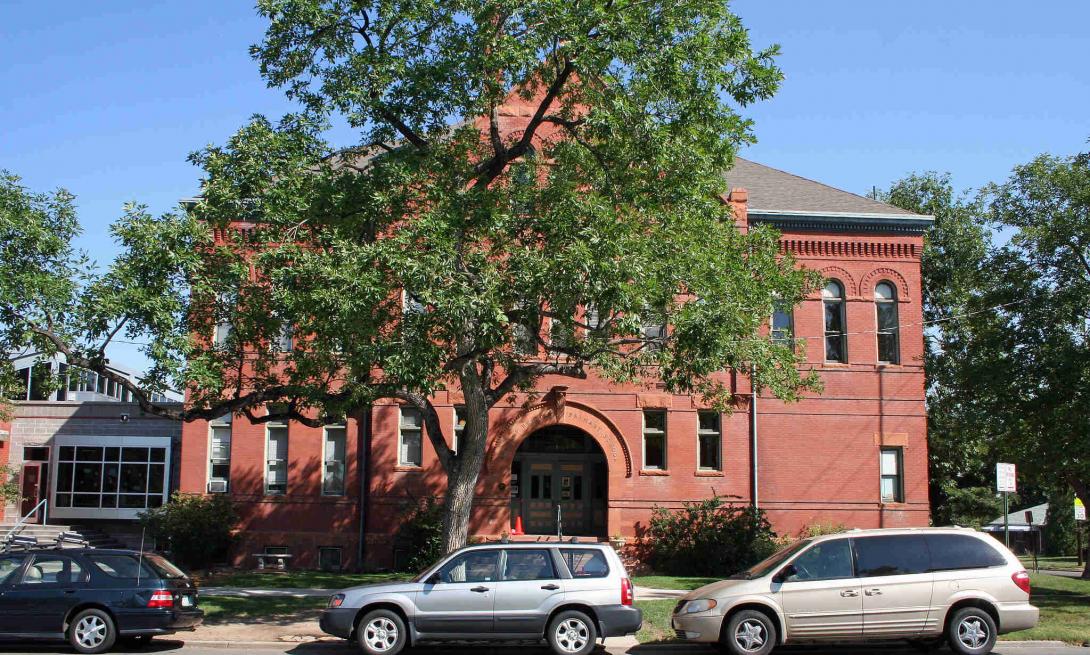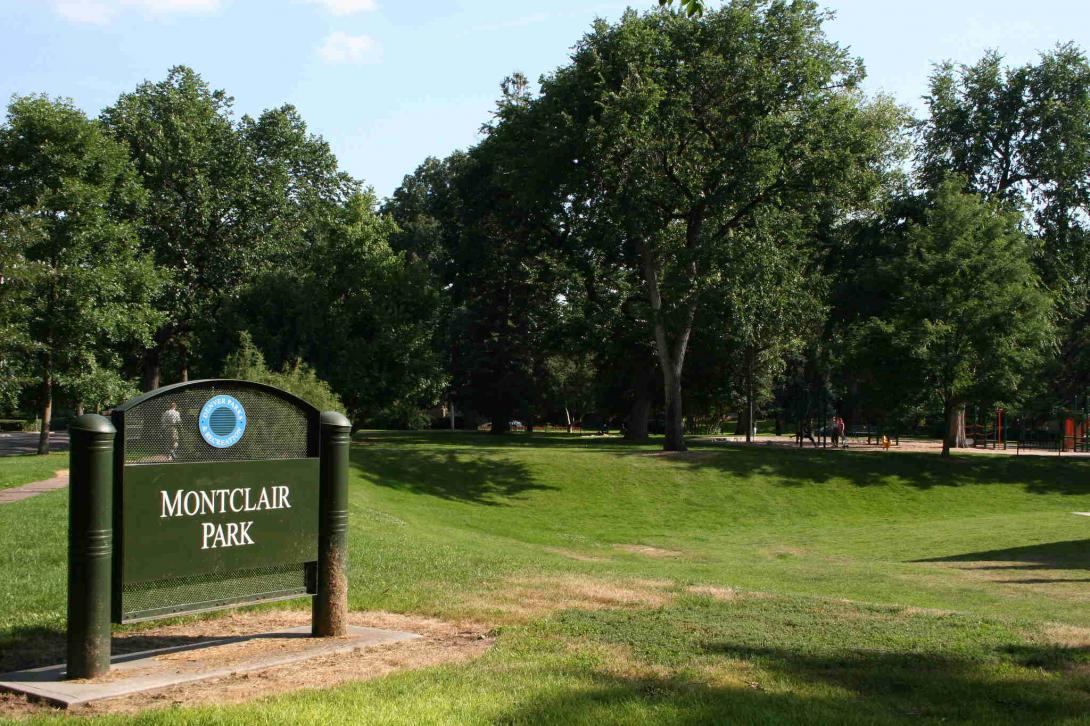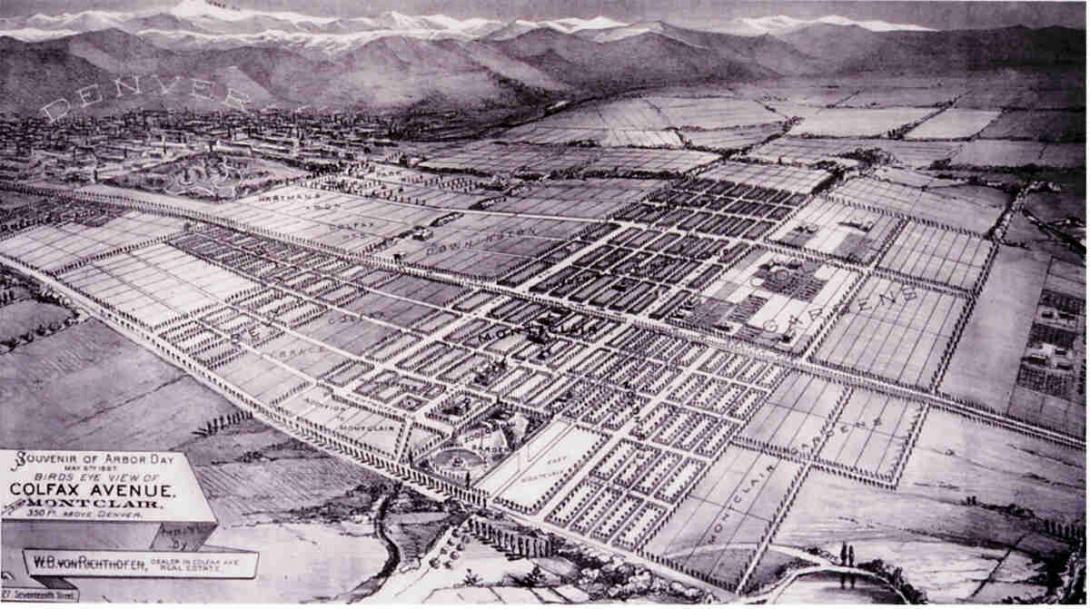Montclair
Full Article
Situated on the east side of Denver and rising some 330 feet above the State Capitol’s gold dome, the town of Montclair was platted in 1885. The common French place-name means “clear mountain,” and Montclair was so named for its panoramic view of the Front Range between Pikes and Longs Peaks. At the time, Montclair lay far beyond the city limits, out on the prairie. Its early boosters claimed that this made the town an escape from big-city problems such as crime, poverty, and unhealthy conditions.
Annexed to Denver in 1902, the neighborhood—encompassing East Colfax Avenue to East Sixth Avenue, between Quebec and Holly Streets—now has roughly 6,500 residents and includes a smaller Montclair Historic District designated in 1975.
Early Montclair
Montclair owes its existence mainly to Baron Walter von Richthofen. The bushy-bearded Baron came from a famous German clan. He was a kinsman of the geographer Baron Ferdinand von Richthofen, for whom the Colorado mountain is named, and a cousin of the Red Baron, the famed World War I fighter pilot. Walter, who was born in Kreisenitz, Silesia, in 1848, had fought in the Franco-Prussian War of 1870–71. He then sailed to the United States and eventually landed in Colorado around 1877.
In the mid-1880s, the Baron made his first investment in Denver real estate, a tract that ran from Lake Archer to Lipan Street between West First and West Ellsworth Avenues, known as “Richthofen’s Addition.” He also invested in some north Denver developments. All fizzled.
Turning his attention to east Denver, he joined Matthias Cochrane’s Montclair Town and Improvement Company, then thriving during Colorado’s 1880s mining boom. Cochrane hailed from the suburb of Montclair, New Jersey, giving a second reason for the name. In 1885 the Rocky Mountain News described the welcome reprieve that Montclair, Colorado, would offer in an increasingly industrialized state: “Its cooling breezes from the mountains, uncontaminated by smelter smoke, bring health and vigor to this favored locality.”
As a show home for the fledgling town, Richthofen built a castle for himself at East Twelfth Avenue and Olive Street. This stone Romanesque Revival landmark boasted a crenelated parapet and a tower that dominated the east Denver skyline. To help his suburb flower, Richthofen and associates dug the Montclair Ditch off the Highline Canal. It flowed north along Quebec Street to Richthofen Castle and then downhill to the Molkery (milk house), a spa for health-seekers on East Twelfth Avenue.
The Molkery’s rural feel, fresh milk, and open-air porches provided a respite for those suffering from tuberculosis and other lung disorders. In 1911 the Molkery was repurposed into Denver’s first neighborhood civic center. Now landmarked, it remains a Montclair neighborhood hub.
To connect Montclair with downtown, Richthofen and other promoters coaxed streetcar lines along East Eighth, Colfax, and Seventeenth Avenues. These routes turned Montclair into a streetcar suburb. To attract the more affluent, Montclair offered lots twice the width of the core city’s twenty-five-foot-wide parcels. Houses initially had to be three stories, cost at least $10,000, and have plans approved by the Montclair Board of Supervisors.
To attract residents, the Baron ran bright red coaches from downtown out to Montclair. As the Baron blew his tally-ho horn and all-aboard cry, his Russian wolfhounds dashed ahead, frantically leading Denverites to a house-site hunt. Customers were encouraged to buy a whole block where they could build their own house and either farm the remaining land or sell it to others. The pattern of one large old home per block distinguishes Montclair to this day, with most of the other lots filled by one-story houses added after World War II.
Montclair was incorporated as a separate town in 1888 to provide its own services. A town hall was built at East Fourteenth Avenue and Oneida Street, where the Montclair Fire Station now stands. In addition to their own town government, the citizens of Montclair started a police and fire department, a school system, and a weekly newspaper, the Montclair Mirror. Richthofen even planned a zoo, which never materialized.
The scramble for land in this suburban paradise ended abruptly with the Panic of 1893. Prairie dogs repossessed vacant lots, while prickly pear cactus and sunflowers decorated empty basement excavations. The 1900 Census counted only eighty-eight families living in the town (which originally included parts of what are now Park Hill and Lowry). In 1902 Montclair was annexed to the newly created city and county of Denver.
Schools
Early Montclair was home to a remarkable number of educational enterprises. In 1887 Montclair residents organized their own public school system, Colorado School District 44. A year later, Jarvis Hall, which evolved into the Colorado School of Mines, opened along East Tenth Avenue near Quebec Street. This Episcopal school stood four stories tall before it burned to the ground in 1901. The Jarvis Hall Chapel survives as today’s St. Luke’s Episcopal Church (1890) at East Thirteenth Avenue and Poplar Street, now a designated landmark. A few blocks north, Colorado Women’s College started in 1890 at Quebec Street and Montview Boulevard. The college merged with the University of Denver in 1982. Its main building, Treat Hall, is now a designated landmark.
Montclair’s original frame schoolhouse sat next to the fire station and town hall on Oneida Street near East Colfax Avenue. In 1891 it was replaced by the still-standing, brick-and-stone Stanley School at East Thirteenth Avenue and Quebec Street, which featured Colorado’s first public school kindergarten. Named for the Welsh American explorer Henry M. Stanley, the school became so crowded that a gymnasium and kindergarten building was built on its west side. Now a designated Denver landmark, it has been converted to the private Paddington Station Preschool.
Health Spa
Desperate and overextended after the 1893 crash, the Baron remarketed Montclair as the Colorado Carlsbad, named for the famed German resort. When told that Montclair had no hot springs or mineral waters, Richthofen proposed building an aqueduct to channel in hot water from Idaho Springs. He planned a neoclassical-style resort with a lavish bathhouse, casino, and hotel. None of this materialized.
A decade later, future US senator and business tycoon Lawrence C. Phipps built the Agnes Phipps Memorial Sanatorium, the largest tuberculosis sanatorium in Colorado, at the site, naming it for his mother. In the 1930s, the site would become part of Lowry Air Base. When that was decommissioned, it was replaced in the 1990s by the Lowry neighborhood.
With the Phipps Memorial Sanatorium nearby, many health seekers built houses in Montclair, where distinctive residences feature screened porches and open floor plans to help capture fresh air. Tuberculosis was then the deadliest killer in the country, and there was no sure cure, though a sunny, dry climate was often prescribed. The explosive growth of the University of Colorado Health Sciences Center (now Anschutz Medical Campus) and National Jewish Hospital just west of Montclair reflected Denver’s emergence as a national health care center by the 1920s.
Modern Montclair
After World War II, Montclair finally began to boom, when many in the medical profession or veterans once stationed at nearby Lowry Air Base moved into the neighborhood. To accommodate the influx of residents, the Montclair Elementary School opened in 1943 at Richthofen Place and Newport Street, and nearby St. James Catholic School opened five years later.
In the 1950s, one of Denver’s early shopping centers, Mayfair, opened with a new grocery chain called King Soopers as its anchor. As a new commercial anchor, Mayfair gave its name to the nearby area, which officially remains the western portion of the Montclair neighborhood. By 1960 Montclair had grown to 7,396 residents. Some whites fled the area during the busing and integration initiatives of the 1960s and 1970s. The remaining residents revived the inactive Montclair Civic Association, founded back in 1911, to deal with busing and other local issues. After the courts ordered districtwide busing to create racially balanced schools, Black kids from other neighborhoods were bused into predominantly white Montclair schools, while white Montclair students were bused to largely Black neighborhood schools. To facilitate this controversial change, the neighborhood group, renamed the Historic Montclair Community Association, began issuing a quarterly newsletter, hosting seasonal activities, and sponsoring house tours.
The association also supported the 1975 designation of the Montclair Historic District. The district covered the heart of the original neighborhood, stretching roughly from East Seventh to East Twelfth Avenue between Newport and Poplar Streets. Opponents pointed out that most houses were built after World War II and were of dubious architectural merit. City councilwoman Cathy Donahue responded, “This successful blending of the new and the old is precisely the charm of Montclair.” Montclair features residential styles from the late 1800s to today, including Queen Anne, Tudor Revival, Four Square, Spanish Revival, Classic Cottage, bungalow, ranch, modern, and contemporary. Designs in the style of Frank Lloyd Wright were contributed by notable resident architects Victor Hornbein and Joe Marlow.
Today
By 2020 Montclair had a population of 6,541. The decline since the postwar period was because the area had far fewer children than in previous decades as the suburban baby boom moved outward. The 2020 population was about 73 percent white, 20 percent Latino, 2 percent Black, 1 percent Asian, and 4 percent two or more races, with a median income of nearly $125,000.
In the 1880s, Montclair was one of the first communities to coax Denverites out of the city. Today it draws people in, leading to rising housing prices. In recent years, the eastern portion of Montclair near the Mayfair shopping center has been transformed as wealthy buyers tear down one-story postwar houses and replace them with much larger and more expensive residences. Still, Baron von Richthofen’s dreams persisted in the tree-shaded streets and parkways he planned. Montclair has preserved its historic sites and streetscapes. The castle and the Molkery remain standing and fully restored. The old Richthofen Stables became town houses but retained a horse-watering trough. Richthofen Parkway and Richthofen Place were included in the Montclair Historic District, along with the granite Richthofen Fountain.











